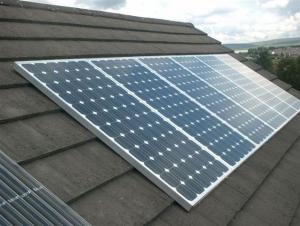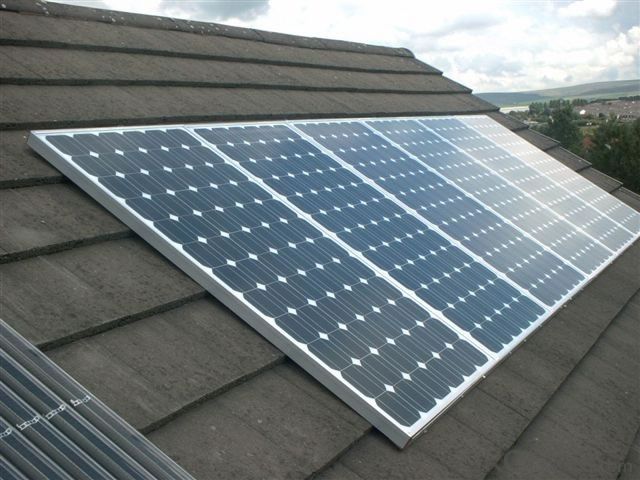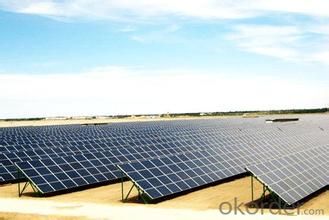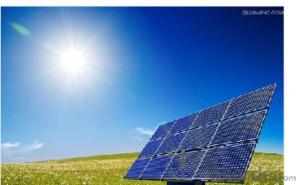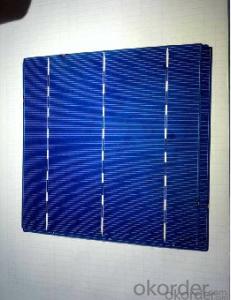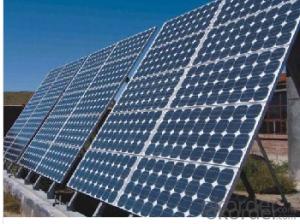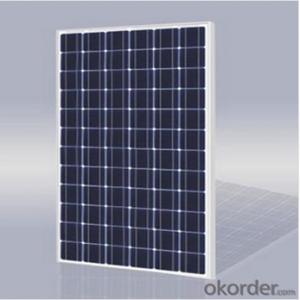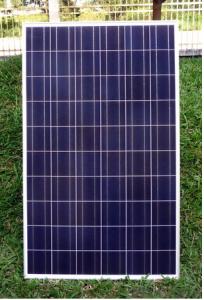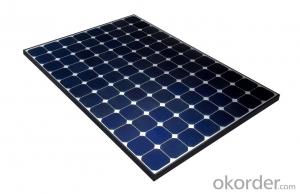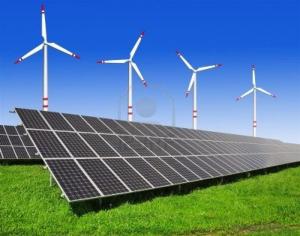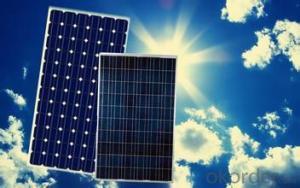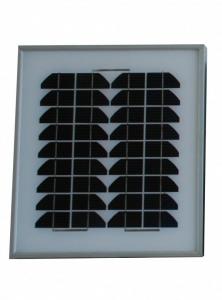30 Watt Solar Panels - 45w CNBM Polycrystalline Silicon Panel for Home Use
- Loading Port:
- Shanghai
- Payment Terms:
- TT OR LC
- Min Order Qty:
- 100 watt
- Supply Capability:
- 1000 watt/month
OKorder Service Pledge
OKorder Financial Service
You Might Also Like
Specification
45W CNBM Polycrystalline Silicon Panel for Home Using
Production description
Most solar modules are currently produced from crystalline silicon (c-Si) solar cells made of multicrystalline andmonocrystalline silicon. In 2013, crystalline silicon accounted for more than 90 percent of worldwide PV production, while the rest of the overall market is made up of thin-film technologies using cadmium telluride, CIGS and amorphous silicon[7]Emerging, third generation solar technologies use advanced thin-film cells. They produce a relatively high-efficiency conversion for the low cost compared to other solar technologies. Also, high-cost, high-efficiency, and close-packed rectangular multi-junction (MJ) cells are preferably used in solar panels on spacecraft, as they offer the highest ratio of generated power per kilogram lifted into space. MJ-cells are compound semiconductors and made of gallium arsenide (GaAs) and other semiconductor materials. Another emerging PV technology using MJ-cells is concentrator photovoltaics (CPV).
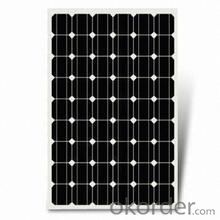
Feature
1.High conversion efficiencies resulting in superior power output performance.
2.Outstanding power output even in low light or high temperature conditions
3.Optimized design for ease of soldering and lamination
4.Long-term stability,reliability and performance
5.Low breakage rate
6.Color uniformaity
Physical characteristic
1. Rigorous quality control meets the highest international standards.
2. High-transmissivity low-iron tempered glass, strong aluminium frame.
3. Using UV-resistant silicon.
4. IS09001/14001/CE/TUV/UL
- Q: My mom's house has some solar power panels on the top of her house but they are not connected to anything. They don't even have wires or anything like that. Does anyone know how to connect and make solar panels work? Thank You
- I do not know, but there is a house in Lafayette which was built with solar power. It was to have a solar system, so the contractor's first act was to put up a solar array on the property. It had battery backup, and was used to provide the electrical power during construction. during completion of the house the solar system was installed on the roof of the house.
- Q: So, I've seen cheap solar panel kits for sale from Harbor Freight, and regardless of whether or not I were to buy a set from them or someone else, I was wondering what the process of implementing a small-scale solar system into your household electrical system would be.I've read articles that started out too in-depth or were speaking of systems on a much larger scale.Can it be as easy as buying the panels and inverter, and plugging it into a socket, or is there more to it?Some of the articles I was reading had mentioned having to contract with your electrical supplier, having to have an electrician tie it all in in some special/ necessary way, using a battery pack (would this be necessary for a tied-in system?), or using the system to only power single items, like a water heater, or plugging items into a connected battery-pack, all of which I'm not sure is necessary or needed for what my goals/ means are/ would be.
- Grid tie inverters are expensive, but you might find a used one cheap on E-Bay, Crags list. Almost any grid tie inverter will work as you are thinking low power, but it likely needs to be 50 hertz or 60 hertz, which ever you have, and 230 volts ac or 20 volts ac which ever you have. It will work for a range of dc voltages, so your solar panels need to produce voltage near the center of that range. I considered buy the 3 PV panel set of 5 watt panels that Harbor freight sells. but I did not determine if the three panels can be conveniently connected in series to produce about 50 volts at light loads, or 00 volts if you buy two sets. You probably do not need the load controller, that comes with each set. I think most grid tie inverters automatically adjust to the dc voltage you supply them, unless it is below some minimum such as 50 volts. It is illegal to connect ordinary inverters to the power company, but they will probably not notice a small system unless you burn your house down. Most inverters will phase lock with the power companies frequency, but they are not designed to do that, so bad is likely unless you connect a resistor such as 0 ohms at 00 watts in series with the ac out of the inverter. If the resistor smokes you should disconnect promptly, then try again to see if you can get phase lock quickly. No smoke, likely means you are one of about 000 co-generators on the electric grid, You can short out the resistor with short piece of very fine wire which will hopefully melt if something goes wrong, such as the power company not sending electricity for 0. seconds or longer. Nearly all inverters have an over load feature, so the thin wire is a back up. Please be careful as people sometimes don't survive an electric shock at 20 volts.
- Q: Can anyone give me a link to a website that sells really big solar panels? Enough to run a small cafe on entirely solar power.
- Just google search solar panels or pv panels and you should get a long list of them. That's what I did. Most of the sites selling them will also have the inverters etc that you'll need. Most likely you'll put several small or medium sized panels on your roof - as opposed to just one large one. You probably won't be able to run an entire cafe off of photovoltaic panels, even if you have a bank of batteries. Too many appliances running at the same time. Ask your electric utility company about net metering - you'll buy juice from them when your demand is high and sell to them when your demand is low - IF you can find a sunny day when you're not using juice, but if you have a restaraunt-sized refrigerator you probably won't be selling as much as you're buying. In effect, it won't eliminate your elec bill, just make it a bit smaller. Either way, you may be looking at spending $20,000 to cover the roof with PV panels and your savings won't pay that back any time soon. So, PV is not so great for a business. Much better for a home where you'll be at work all day the only appliances running in your house is your frig. Whatever you invest to solar your house will be repaid when you sell it, meanwhile you'll reduce your bills dramatically, especially if you convert all your indoor lighting to LEDs. On the other hand, the Googleplex, Google's office building full of computers, covered their roof with pv panels and claim to have reduced their monthly bill by /3. BUT, that's a huge building with lots of roof space.
- Q: I need to reduce the average monthly home electricity bill by powering some of the household appliances using solar panels. Can I use a 250 watt solar panel to power a medium sized upright fridge?
- Solar panel alone? No. With the appropriate storage system and inverter, perhaps. You will need to do the calculation - as follows: In a solar day that averages about eight hours, you will generate about 67% of your rated output over those 8 hours. That means you will have made 340 watts. Your refrigerator will run for about four (4) hours per day on average if you are very careful about opening and closing. If you have a 400-watt (average-when-running) fridge, you will have a small cushion that will be absorbed by inverter losses, charger losses and so forth. So, with an adequate set of storage batteries, a good charger and a good inverter, you just might be able to operate that small fridge. No icemaker, no other power drains. But, two 250-watt panels would be better.
- Q: I recently got into solar panels, I have little background in electronics but I have done a little electrical work in the past and just want to make a small 36 cell panel to power a 2v battery that would run my a small tv (9 inch) and PS3 for a few hours every night. I have been looking up on how to do it before I get in over my head and I have a few questions.... After you solder all of the cells together then what? Do you hook all of the rows of cells together somehow? Can you connect them straight to a battery? After you hook to the battery do you hook up a power inverter to get the 2 AC plugs that would be needed? Thanks in advance for any help....
- I'll add a few comments to Teelo's It may not be good to connect the assembled solar cells directly to the battery. When there is no sun I think it will drain the battery. I'm pretty sure all circuits I have seen have a reverse polarity diode in series. (unless Teelo knows for sure). Hmmm Reminds me that I have some bare solar cell elements from when Motorola was making them. I used some to power a small radio controlled car. I do know that all good applications have a regulator to make sure the charging is done properly
- Q: How much space do solar panels require?
- The space required for solar panels depends on several factors such as the power output of the panels and the efficiency of the solar cells. On average, a typical solar panel requires around 10-20 square feet of space. However, it is important to note that solar panels can be mounted on rooftops, installed in large solar farms, or even integrated into building materials, allowing for flexibility in their placement and utilization of available space.
- Q: How do solar panels impact the electricity bill?
- Solar panels can significantly reduce or even eliminate electricity bills by generating clean and renewable energy from the sun. By harnessing solar power, homeowners can offset their electricity consumption and potentially earn credits by selling excess energy back to the grid. This can lead to substantial savings on monthly electricity bills.
- Q: Can solar panels be used in areas with high levels of windstorms?
- Yes, solar panels can be used in areas with high levels of windstorms. However, it is important to ensure that the solar panels are properly installed and secured to withstand the strong winds. Additional measures such as reinforced mounting structures and regular maintenance can also be taken to enhance their durability in such conditions.
- Q: How do I hook up solar panels to my home
- The fourth answer (kinetic energy) is totally wrong except for follow the instructions If you don't have the basic qualifications, you shouldn't even try besides falling off your roof and electrocuting someone else with bad connections. Solar panels produce low voltage DC power (up to 48 volts depending on design) which can be used directly but rarely is. DC power is stored in batteries for night, overcast days, and times of higher usage. The battery power must be fed through an inverter to produce 20 (or 240) volt AC power that your appliances use. The inverter to house connection must be made in a way that when the main power is turned off (like for repairs) your solar sourced power is not on the wires to hurt someone.
- Q: I have two solar panels and I have measured that they produce V by themselves. I am trying to generate .5V, but whenever I hook them up in parallel I get something like .02V. What it happening?
- . You want series, not parallel. (Add the voltages. Coonect '+' of the first to '-' of the next, and take your feed from the extreme ends.) 2. if you parallel them and you get less voltage than one alone, you got your polarity crossed up and are reading the difference between them.
Send your message to us
30 Watt Solar Panels - 45w CNBM Polycrystalline Silicon Panel for Home Use
- Loading Port:
- Shanghai
- Payment Terms:
- TT OR LC
- Min Order Qty:
- 100 watt
- Supply Capability:
- 1000 watt/month
OKorder Service Pledge
OKorder Financial Service
Similar products
Hot products
Hot Searches
Related keywords
